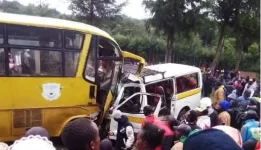A deadly crash between a school bus and a matatu happened Friday evening at Kimalany Bridge on the Molo-Keringet road. The head-on collision killed at least two people. Several others suffered injuries from the violent impact. Police arrived quickly to manage the accident scene.
Police commander Timon Odingo from Molo Sub-county explained how the crash occurred. The Nissan matatu headed toward Molo when it slammed into the oncoming school bus. Those students inside were going home toward Keringet. The force of the vehicles hitting each other caused major damage.
Odingo told reporters his team had begun looking into what caused the tragic accident. They plan to examine road conditions, vehicle speeds, and driver actions. The investigation might take days to complete. Officials hope to prevent similar crashes through their findings.
People who saw the crash described how powerful the impact looked. The matatu hit with such force that its front hood became stuck inside the school bus. Bystanders rushed to help before emergency crews arrived. They described hearing a loud bang followed by screams.
Rescue teams took many hurt people to different medical centers based on injury severity. The subcounty hospital received some victims with minor wounds. Others needed specialized care at Nakuru PGH hospital. Doctors fear the death count may increase as critically injured patients receive treatment.
This dangerous spot at Kimalany Bridge has caused multiple fatal crashes. Local residents have repeatedly asked authorities to fix the unsafe road conditions. They blame poor design and a lack of safety features for these accidents. Many have petitioned the road agency for urgent improvements.
Heavy rains across the region likely made driving conditions much worse. Water reduces tire grip on pavement and creates slippery surfaces, and drivers struggle to see clearly through rain-covered windshields. These factors probably contributed to the deadly collision.
Just two weeks earlier, another terrible crash had killed 14 people riding a Nissan matatu. That accident happened when a truck lost control near Migaa by Salgaa. The deadly collision occurred on the busy Nakuru-Eldoret Highway. No one survived the immediate impact of that crash.
That notorious highway earned a reputation as a deadly route for drivers over many years. Officials eventually installed safety measures to reduce accidents. They built concrete barriers separating traffic moving in opposite ways. These changes aimed to prevent head-on collisions between vehicles.
These safety improvements dramatically lowered accident rates along that dangerous stretch. Most people remember the area for the horrible Sachangwan disaster years ago. That tragedy killed more than 130 people when spilled fuel from a crashed tanker caught fire. Many victims had gathered to collect free fuel before the explosion.
Police commander Timon Odingo from Molo Sub-county explained how the crash occurred. The Nissan matatu headed toward Molo when it slammed into the oncoming school bus. Those students inside were going home toward Keringet. The force of the vehicles hitting each other caused major damage.
Odingo told reporters his team had begun looking into what caused the tragic accident. They plan to examine road conditions, vehicle speeds, and driver actions. The investigation might take days to complete. Officials hope to prevent similar crashes through their findings.
People who saw the crash described how powerful the impact looked. The matatu hit with such force that its front hood became stuck inside the school bus. Bystanders rushed to help before emergency crews arrived. They described hearing a loud bang followed by screams.
Rescue teams took many hurt people to different medical centers based on injury severity. The subcounty hospital received some victims with minor wounds. Others needed specialized care at Nakuru PGH hospital. Doctors fear the death count may increase as critically injured patients receive treatment.
This dangerous spot at Kimalany Bridge has caused multiple fatal crashes. Local residents have repeatedly asked authorities to fix the unsafe road conditions. They blame poor design and a lack of safety features for these accidents. Many have petitioned the road agency for urgent improvements.
Heavy rains across the region likely made driving conditions much worse. Water reduces tire grip on pavement and creates slippery surfaces, and drivers struggle to see clearly through rain-covered windshields. These factors probably contributed to the deadly collision.
Just two weeks earlier, another terrible crash had killed 14 people riding a Nissan matatu. That accident happened when a truck lost control near Migaa by Salgaa. The deadly collision occurred on the busy Nakuru-Eldoret Highway. No one survived the immediate impact of that crash.
That notorious highway earned a reputation as a deadly route for drivers over many years. Officials eventually installed safety measures to reduce accidents. They built concrete barriers separating traffic moving in opposite ways. These changes aimed to prevent head-on collisions between vehicles.
These safety improvements dramatically lowered accident rates along that dangerous stretch. Most people remember the area for the horrible Sachangwan disaster years ago. That tragedy killed more than 130 people when spilled fuel from a crashed tanker caught fire. Many victims had gathered to collect free fuel before the explosion.












